The Q1 was completed in May 1942. Unfortunately, wartime restrictions limited the development of the new locomotive. That, and the adoption of the Chesapeake & Ohio T-1 design as the Pennsylvania J1 class, filled a vacant slot in the Pennsy’s roster that had been earmarked for the Q1. This sealed the Q1’s fate as a one-of-a-kind model.
The locomotive’s operation career was spent running in the Pennsy’s western region, often between Columbus, Ohio, and Chicago. The Q1 was dropped from the roster in January 1952.
The model
Third Rail offers both skirted and unskirted versions of the Q1. As was common with streamlined locomotives, it was easier for railroads to maintain these machines with their streamlined panels removed, and many such locomotives “lost their skirts” in their later years of operation. Which 3rd Rail version is nicer is a flip of the coin. The skirted says “streamlined speed.” The unskirted version says “mechanical strength.”
Both versions pack a ton of detail that mirrors prototype photos and diagrams in reference books. The model’s coupler-to-coupler length is 124 scale feet (31 inches) compared to the prototype’s 122 feet, 9 inches. The difference is accounted for by the model’s oversized O gauge coupler and the length of the drawbar connecting the locomotive and tender.
The brass body shell on each model we examined is smooth and flawless. The streamlined version’s nose juts out with a wonderful assortment of latches around a simulated smokebox door. The familiar PRR keystone is mounted on the snout. Above is a headlight, and number boards are on the top of the locomotive behind the recessed stack.
The nose of the unskirted version is flatter but with an equally nice batch of latches and handrails. Number boards are on either side of the headlight. Both models feature scale-sized drop couplers up front, mounted in the smooth pilots.
The boilers on both models feature plenty of rivet and seam detail. Add-on pieces include bells and whistles as well as builder’s plates.
As per the Pennsy’s design, the second set of steam chests is in an unusual position. Look at the photos and you’ll see that the rear set of drivers faces backward.
It is a first-rate visual pleasure to watch the synchronized bright-metal running gear operate in a most unconventional pattern against the Brunswick green drive wheels. Here, the unskirted version has the edge, but even the skirted version allows you to see enough of the moving rods while under way to create a fascinating view.
The cab has an opening roof hatch and a fully decorated backhead with painted gauges and valve handles. There is also a textured deckplate that folds down between the cab and the massive, 16-wheel model 180F 75 tender.
Paint and decoration are perfect. The Brunswick green and the smokebox gray paint were applied evenly and clearly on both models. The lettering and numbering are superb.
On the test track
We tested both versions of the locomotive. Each requires O-72 curves. Only the first and last set of drivers have flanges, so don’t be surprised to see wheels overhanging the rails on O-72 curves. While it doesn’t bother me, you may want to run your Q1 on even wider curves to avoid any overhang.
Operating in conventional-control mode, the locomotives averaged 12.7 scale mph on the low end and 79.5 scale mph on the high end. In command-control mode, the locomotives’ low-speed average dropped to 5.5 scale mph, assisted by its “Engineer on Board” speed-control circuitry.
I was a bit surprised by the drawbar pull of the 11-pound, 5-ounce locomotives. I put both the skirted and unskirted sample locomotives through our drawbar pull test several times and racked up just 1 pound. Hardly the tree-stump pulling you might expect from models this large, each of which is equipped with a pair of traction tires. Using our normal rule of thumb, 1 pound equals approximately 46 modern, free-rolling cars on straight and level track.
Running the locomotives on my home layout, they easily pulled my 25-car test train comprised of rolling stock of mixed makes and vintages. Running wide open at 18 volts in conventional-control mode, the 25-car train hit 73.4 scale mph. Not bad at all.
Each locomotive has a single can-style motor mounted below the cab that offers exceptionally quiet performance. The drive shaft in each of the models is cleverly hidden within the axle-frame assembly, allowing boiler details to reach down and around the belly of the models. There’s no “hole” for gears or shafts.
Looking at the forward set of six drivers, you’ll see that the lead wheels are flanged and the other two sets are blind. With the rear set of four drivers, you’ll see that the rear two wheels are flanged and have traction tires.
The locomotives look terrific under way, and, as I said before, the unusual positioning of the steam chests provides some eye-popping rod action.
There were no jerks or balks from either locomotive during the break-in period. Out of the box the running gear was a bit squeaky, but a little oil remedied that. All Lionel TrainMaster Command Control functions worked properly.
Fan-driven smoke production was commendable, and the locomotive’s Train America Engineer-On-Board cruise-control system worked well.
With 10 driving wheels mounted on a rigid frame, both versions of the Q1 are happiest on smooth trackwork (I experienced a pair of unpleasant derailments on some undulating sections of track on my home layout).
If you have an eye for big steam power, or Pennsy engines are on your “must-have” list, take a long look at the Q1.














